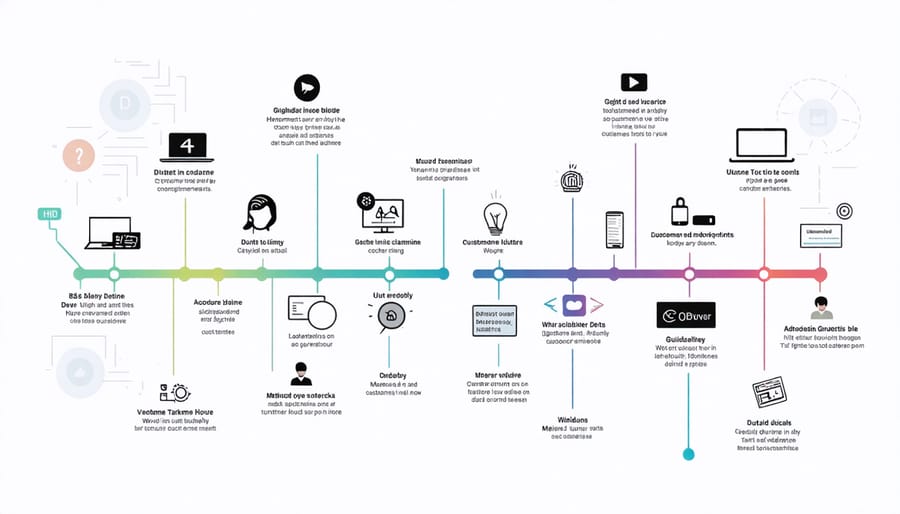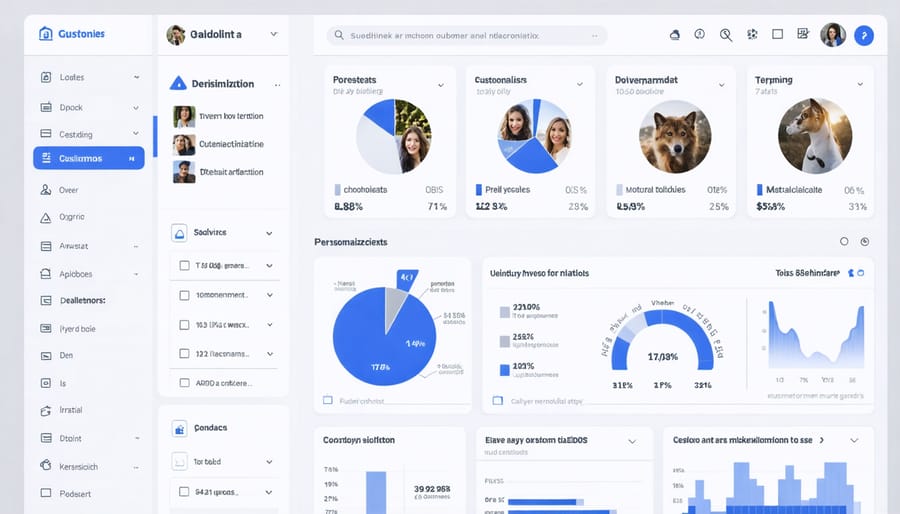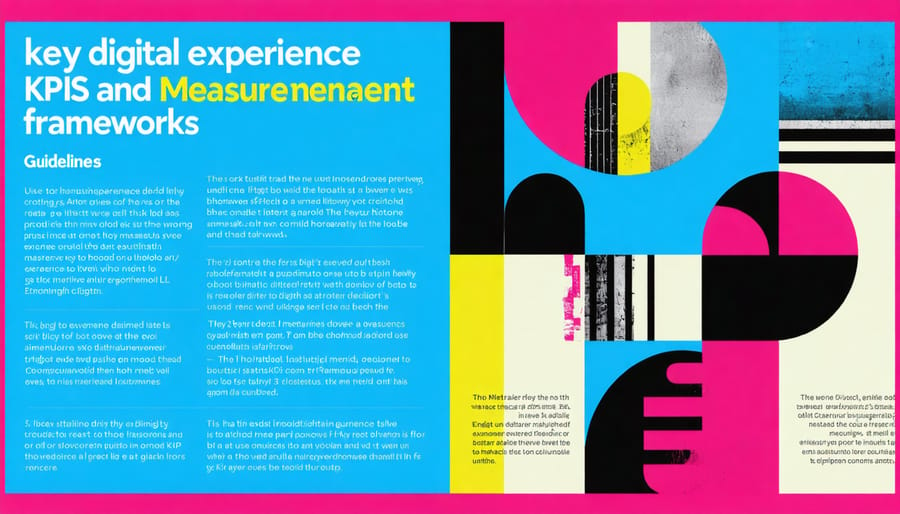How Digital Transformation Is Revolutionizing Customer Experience (Real Results Inside)

In today’s hyper-connected marketplace, digital transformation isn’t just about implementing new technologies—it’s about fundamentally reimagining customer interactions at every touchpoint. Organizations that successfully integrate digital solutions into their customer experience see an average 25% increase in satisfaction rates and a 20% boost in customer retention.
Digital transformation revolutionizes customer experience through three critical dimensions: personalization at scale, seamless omnichannel engagement, and data-driven decision making. By leveraging artificial intelligence, cloud computing, and advanced analytics, businesses can now deliver highly personalized experiences that anticipate customer needs before they arise.
The stakes couldn’t be higher: 80% of customers now consider their experience with a company to be as important as its products or services. Companies that fail to adapt risk losing market share to more digitally mature competitors who provide the frictionless, intuitive experiences that modern consumers demand.
Yet successful digital transformation isn’t about technology alone—it’s about putting the customer at the center of every digital initiative. This means understanding customer journeys, pain points, and preferences, then strategically deploying digital solutions that create meaningful improvements in how customers interact with your brand.
Let’s explore how your organization can navigate this critical evolution while delivering exceptional customer experiences that drive growth and loyalty.
The New Digital Customer Journey

Mapping Digital Touchpoints
Identifying and mapping digital touchpoints is crucial for understanding how customers interact with your business across various digital channels. Start by documenting every point where customers engage with your brand online, from social media interactions to website visits, email communications, and mobile app usage.
Create a comprehensive touchpoint map that outlines the customer’s digital journey, beginning with their first awareness of your brand through to post-purchase support. Key touchpoints typically include social media engagement, website navigation, online chat interactions, digital payment processes, and automated email communications.
For each touchpoint, assess its current effectiveness and identify opportunities for improvement. Consider factors such as load times, interface design, response rates, and customer satisfaction metrics. Pay special attention to transition points where customers move between different channels or platforms.
Implement analytics tools to track customer behavior at each touchpoint, measuring metrics like engagement rates, conversion rates, and customer satisfaction scores. This data-driven approach helps identify bottlenecks and areas where the digital experience can be enhanced.
Remember that touchpoints should work seamlessly together to create a cohesive customer experience. Regular evaluation and optimization of these digital interactions ensure your business stays aligned with evolving customer expectations.
Customer Expectations in a Digital World
Today’s customers expect seamless, personalized experiences across all digital touchpoints. They demand instant access to information, quick response times, and consistent service quality whether they’re interacting with a business through social media, mobile apps, or websites.
Research shows that 76% of customers expect companies to understand their needs and expectations, while 84% say the experience a company provides is as important as its products or services. Modern consumers value convenience, speed, and personalization above all else.
Key customer expectations in the digital age include:
– 24/7 availability through multiple channels
– Personalized recommendations and communications
– Self-service options for routine transactions
– Fast response times (usually within minutes, not hours)
– Seamless transitions between digital and physical experiences
– Mobile-first experiences
– Data privacy and security
Businesses must recognize that these expectations aren’t just “nice-to-haves” but essential requirements for survival in today’s market. Companies that fail to meet these digital expectations risk losing customers to more technologically advanced competitors. To succeed, organizations need to constantly monitor and adapt to evolving customer preferences while maintaining a balance between automation and human touch.
Building Your Digital Experience Framework
Data-Driven Personalization
In today’s digital landscape, personalization has evolved from a luxury to a necessity. By leveraging customer data effectively, businesses can create tailored experiences that significantly improve customer satisfaction and loyalty. The key lies in collecting and analyzing relevant data points throughout the customer journey.
Start by implementing robust data collection methods across all customer touchpoints, including website interactions, purchase history, support tickets, and social media engagement. This comprehensive approach provides a 360-degree view of customer behavior and preferences. Modern CRM systems and analytics tools can help aggregate and process this information efficiently.
To maximize the impact of personalization, focus on these key areas:
– Product recommendations based on browsing and purchase history
– Customized email communications with relevant content and offers
– Personalized website experiences with dynamic content
– Targeted mobile app notifications
– Tailored customer service responses
Remember to maintain a balance between personalization and privacy. Be transparent about data collection practices and ensure compliance with relevant regulations. Implement preference centers where customers can control their data sharing settings and communication preferences.
Measure the effectiveness of your personalization efforts through key metrics such as engagement rates, conversion rates, and customer satisfaction scores. Regularly analyze these metrics to refine your approach and improve outcomes. Start small with basic personalization elements and gradually expand based on results and customer feedback.

Omnichannel Integration
Modern customers expect consistent experiences whether they’re browsing your mobile app, visiting your website, or engaging with your social media channels. Omnichannel integration connects these touchpoints seamlessly, creating a unified customer journey that enhances satisfaction and drives loyalty.
To achieve effective omnichannel integration, businesses must first map their customer touchpoints and understand how users move between channels. This includes traditional channels like email and phone support, as well as emerging technologies like IoT-enabled customer interactions and chatbots.
Key steps for successful implementation include:
– Centralizing customer data across all platforms
– Maintaining consistent messaging and branding
– Enabling real-time synchronization of customer information
– Implementing cross-channel analytics tracking
– Creating unified customer profiles
Remember that true omnichannel integration goes beyond simply being present on multiple channels. It requires seamless transitions between touchpoints, allowing customers to start an interaction on one channel and continue it on another without losing context or having to repeat information. This interconnected approach not only improves customer satisfaction but also provides valuable insights for continuous service improvement.
Automation and AI Implementation
Implementing automation and AI technologies is revolutionizing how businesses interact with their customers. Modern AI-powered automation solutions can handle routine customer inquiries, process transactions, and deliver personalized experiences at scale. By deploying chatbots and virtual assistants, businesses can provide 24/7 customer support while freeing up human agents to handle more complex issues.
Smart automation tools can analyze customer behavior patterns, predict needs, and proactively address concerns before they escalate. For example, automated email systems can send personalized follow-ups based on customer interactions, while AI algorithms can recommend products tailored to individual preferences.
The key to successful implementation lies in striking the right balance between automated efficiency and human touch. Start by identifying repetitive tasks that can be automated, then gradually expand capabilities based on customer feedback and performance metrics. Remember to maintain transparency about automated interactions and always provide an option to connect with human support when needed. This approach ensures that technology enhances rather than replaces meaningful customer relationships.
Measuring Digital Experience Success

Essential KPIs
To effectively measure the success of your digital transformation efforts in customer experience, tracking specific Key Performance Indicators (KPIs) is essential. These metrics provide valuable insights into customer satisfaction, engagement, and the overall effectiveness of your digital initiatives.
Customer Satisfaction Score (CSAT) and Net Promoter Score (NPS) serve as fundamental indicators of customer sentiment. Track these regularly through automated surveys and feedback collection to gauge the immediate impact of your digital improvements.
Digital engagement metrics such as website bounce rates, time on site, and conversion rates offer direct insight into how well your digital touchpoints perform. Monitor cart abandonment rates for e-commerce operations, and track digital self-service adoption rates to measure the success of automated solutions.
Response time metrics are crucial – measure first response time, average handling time, and resolution time across all digital channels. Set benchmarks for these metrics and continuously work to improve them through automation and process optimization.
Customer effort score (CES) helps understand how easy it is for customers to interact with your digital platforms. Track the number of clicks or steps required to complete common tasks, and work to minimize friction points.
Financial metrics should include customer acquisition costs, digital channel ROI, and customer lifetime value. Monitor these alongside operational efficiency metrics like cost per interaction and automation rate to ensure your digital transformation delivers tangible business value.
Remember to establish baseline measurements before implementing changes and regularly review these KPIs to guide continuous improvement efforts.
Continuous Improvement Strategies
Success in digital transformation requires a commitment to continuous improvement through systematic evaluation and refinement of customer experiences. Start by implementing regular data collection through customer feedback surveys, analytics tracking, and performance metrics. This data should inform decision-making and help identify areas requiring enhancement.
Create a structured feedback loop where customer insights are regularly reviewed and acted upon. Use A/B testing to experiment with different digital interfaces, content formats, and user journeys. Monitor key performance indicators (KPIs) such as customer satisfaction scores, conversion rates, and engagement metrics to measure the impact of changes.
Establish a cross-functional team responsible for analyzing customer experience data and implementing improvements. This team should meet regularly to review metrics, discuss customer feedback, and prioritize enhancement initiatives. Consider implementing agile methodologies to enable quick iterations and responsive changes based on customer needs.
Leverage automation tools to streamline the improvement process. Use AI-powered analytics to identify patterns in customer behavior and predictive modeling to anticipate future needs. Regular system audits help ensure all digital touchpoints remain optimized and aligned with customer expectations.
Remember to maintain open communication channels with customers throughout the improvement process. Share updates about implemented changes and demonstrate how their feedback has influenced improvements. This transparency builds trust and encourages continued customer participation in the optimization process.
Real-World Implementation Steps
Assessment and Planning
Before embarking on a digital transformation journey to enhance customer experience, organizations must conduct a thorough assessment of their current state and develop a comprehensive plan. Start by mapping existing customer touchpoints and identifying pain points in the current customer journey. This analysis should include customer feedback, service metrics, and operational data to establish a clear baseline.
Create a detailed inventory of your current technology stack and digital capabilities. Evaluate which systems are working effectively and which ones need upgrading or replacement. Consider how well your existing tools integrate with each other and support your customer experience goals. Many digital transformation success stories begin with this crucial assessment phase.
Develop clear objectives that align with your business strategy and customer needs. These goals should be SMART (Specific, Measurable, Achievable, Relevant, and Time-bound) and focus on tangible improvements in customer satisfaction, retention, and operational efficiency. Prioritize initiatives based on their potential impact and resource requirements.
Finally, create a roadmap that outlines the implementation sequence, resource allocation, and timeline. Include key milestones, success metrics, and contingency plans. Remember to account for change management and staff training needs, as employee buy-in is crucial for successful digital transformation initiatives.
Technology Selection and Integration
Selecting and integrating the right technology stack is crucial for successful digital transformation of customer experience. Begin by conducting a thorough assessment of your current systems and identifying gaps in your customer journey. Focus on solutions that seamlessly integrate with your existing cloud computing infrastructure while addressing specific customer pain points.
Prioritize technologies that offer:
– Omnichannel capabilities for consistent customer interactions
– Real-time data analytics for personalized experiences
– Mobile-first functionality
– API integration capabilities
– Scalability to grow with your business
When implementing new tools, follow these best practices:
1. Start with a pilot program to test effectiveness
2. Train staff thoroughly before full deployment
3. Collect and analyze user feedback regularly
4. Ensure robust data security measures
5. Maintain flexibility for future upgrades
Consider implementing:
– Customer relationship management (CRM) systems
– AI-powered chatbots for immediate response
– Self-service portals
– Marketing automation tools
– Customer feedback platforms
Remember that technology should enhance, not replace, human interactions. Choose solutions that empower your team to provide better service while automating routine tasks. Regular evaluation of technology performance against customer satisfaction metrics will help ensure your digital transformation efforts remain aligned with customer needs and business objectives.
As businesses continue to navigate the digital landscape, successful customer experience transformation requires a strategic blend of technology adoption, organizational change, and customer-centric thinking. The key to achieving meaningful results lies in taking incremental steps while maintaining a clear vision of the desired outcome.
Start by assessing your current digital maturity and identifying the most pressing pain points in your customer journey. Prioritize initiatives that offer the highest impact with manageable implementation effort. Remember that digital transformation is not a one-time project but an ongoing process of evolution and refinement.
Focus on building a solid foundation with robust data analytics capabilities and integrated systems before moving to more advanced technologies. Ensure your team is properly trained and equipped to handle new digital tools and processes. Regular feedback loops with both customers and employees will help fine-tune your transformation efforts.
Consider creating a digital transformation roadmap that outlines short-term wins and long-term goals. This should include specific metrics for measuring success, timelines for implementation, and resource allocation plans. Don’t forget to factor in regular reviews and adjustments based on performance data and changing market conditions.
The future of customer experience is digital, personalized, and seamlessly integrated across all touchpoints. By embracing digital transformation today, businesses can position themselves to meet evolving customer expectations while maintaining a competitive edge in their market.
Leave a Reply